|
 Nederlands /
Dutch Nederlands /
Dutch
Arachnids
(Arachnida)
| To the class Arachnida belong Arthropods such as spiders, scorpions, harvestmen, ticks and mites. They have eight
legs.
|
Harvestmen, order Opiliones formely Phalangida,
class Arachnida.
Daddy-long-legs, but this name is also used in conjunction with crane
flies and cellar spiders in the family Pholcidae.In 2010 I will
take more photos of harvestmen. They look like spiders.
Features: The two main body sections are grown together to an oval
shaped body (difference with the spiders) They also have no venom or
silk glands. Usually they have a single pair of eyes. The second pair legs
is the longest and works as antennae or sense organs.
Most species are maturing in late summer - hence their common name.
Most harvestmen are active during the night.
Harvestmen catch small insects and other small species, but they also eat
the decays of any dead animal and all kind of plant material and fungi.
A leg (or legs) easily becomes detached from the body. This is
a means of protection from predators. When detached, a leg will
continue to twitch for some time. (sometimes even up to an hour)
They lay eggs in moist soil, under rocks or logs.
|
Red Harvestman, Opilio canestrinii
Family Phalangiidae.
Photos 23-10-2009,13-12-2009.
Striking is the difference in
colour of the male between the orange body and the dark legs. (but
yellow "knees")
The legs of
Opilio parietinus and Opilio saxatilis are less dark. They look like the Opilio
canestrinii.
The Opilio canestrinii has invated Europ fom the Apennines. Since
1993 it is found in the Netherlands. In England in 1999. It lives on
the walls. Other species at walls Opilio parietinus and Opilio saxatilis
are wiped out by the Opilio canestrinii. Most likely the eggs and
harvestmen are imported by transporting plants.
Body
length males: 4 - 6 mm. Females: 5 - 8 mm. The female is yellowish brown
to ocher. The legs has light and dark rings. The eggs are laid in autumn.
Adults June - December. Thanks Arp Kruithof for your
help. |
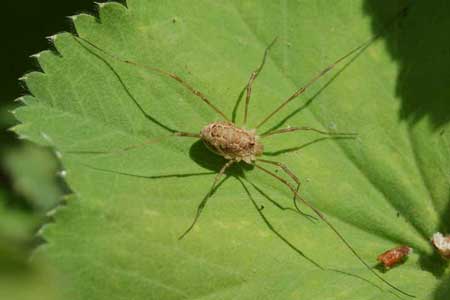 .. ..
 Spring Harvestman
(Rilaena triangularis). Family Phalangiidae. Spring Harvestman
(Rilaena triangularis). Family Phalangiidae.
The spring harvestman is grown mid-April. And is therefore the first
harvestman you see in the spring. April to June. This harvestman don't overwinter as an egg, but as a nymph.
(like the in the Netherlands rare Platybunus pinetorum)
A young spring harvestman. Photo 22-11-2012. |
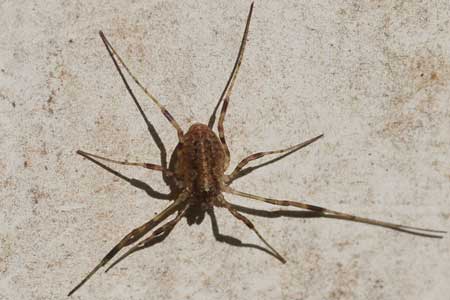 Paroligolophus
agrestis.
Family Phalangiidae. Paroligolophus
agrestis.
Family Phalangiidae.
A harvestman with fairly short legs. The adult
overwinters.
Photo
13-9-2010. |
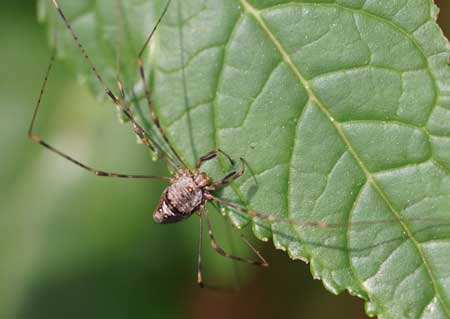 Dicranopalpus
ramosus.
Family Phalangiidae. Dicranopalpus
ramosus.
Family Phalangiidae.
A harvestman with very long legs (up to 5 cm).
In resting position the legs are stretched to the sides. It is also
distinguished by the forked pedipalps.
Native to Morocco. (Discovered in 1909) In the Netherlands it is
discovered in 1992. Now it is a general harvestman. August to November.
Photo 29-9-2010. |
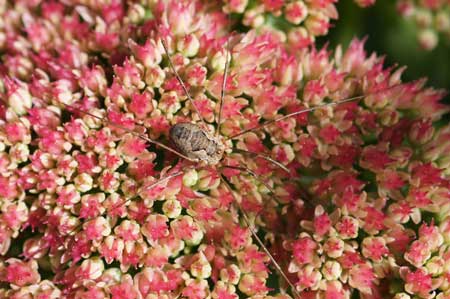 Phalangium
opilio. Family Phalangiidae. Phalangium
opilio. Family Phalangiidae.
A harvestman which can be recognized by the elongated spot on the back with two narrows. (Looks like Mitopus
morio). The underside is light. Length 6 to 9 mm. May to November.
Native to Europe, Asia. But now they live also in North America and North Africa. Photo 25-9-2010. |
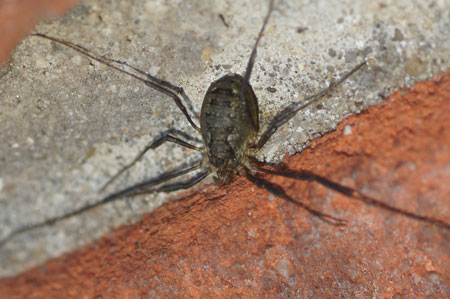 .. ..
 Oligolophus
hanseni.
Family Phalangiidae. Oligolophus
hanseni.
Family Phalangiidae.
In the Netherlands a common harvestman with short legs.
It looks a lot like Paroligolophus agrestis. Females up to 5 mm, males up to 3.5 mm.
It overwinters as an egg. Photos 12-12-2017. |
 Nemastoma
dentigerum. Familie Nemastomatidae. Nemastoma
dentigerum. Familie Nemastomatidae.
In the Nederlands: N. dentigerum, N. lugubre en N.
bimaculatum. N. dentigerum differs from the other two species in the absence of white spots. The male has a small hook on the inside of the palpfemur. A matt black stocky harvestman. Body length: 2-2.5 mm. They occur all year round. Photo 21-3-2022. |
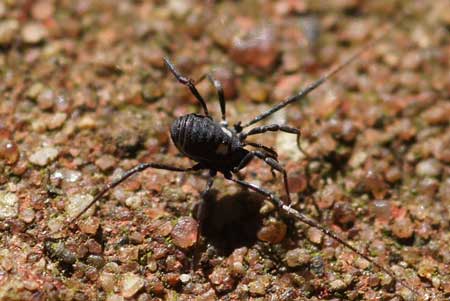 .. ..
 Nemastoma lugubre.
Family Nemastomatidae.
Nemastoma lugubre.
Family Nemastomatidae.
N. bimaculatum is very similar to N.
lugubre but is more rare. It is a dull black harvestman with two striking silvery white spots.
Length body: Male: 1,6-2,7 mm, female: 2,1-2,7 mm. The whole year. Photos
19-3-2011.
|
Family pseudoscorpions (Pseudoscorpiones).
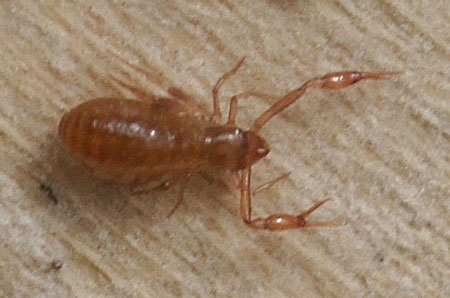 .. ..
 Pseudoscorpion,
false scorpion or book scorpion. Family pseudoscorpions (Pseudoscorpiones). Pseudoscorpion,
false scorpion or book scorpion. Family pseudoscorpions (Pseudoscorpiones).
Every now and then I see them under planks on the ground. (here under a
plank on the compost heap). I can't place everything I see on this website, but
they are very interesting. They look like a scorpion without a tail. They have two very long pedipalps with palpal chelae (pincers) which
look like the pincers of a scorpion. They are small. From 2 to 8 mm. This
one was about 2 mm long. Just like the scorpions, they have a gland, but then
in the pedipalps. With that they can paralyze their prey (for example a springtail). The females can also cling to other, much larger insects like flies to lift up to another area.
They live under fallen leaves, under stones, in moss, etc. In the Netherlands,
there are 23 species. Photos 17-7-2015.
|
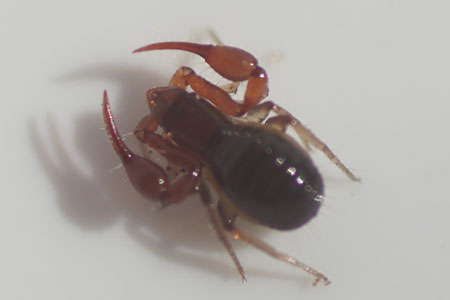 .. ..
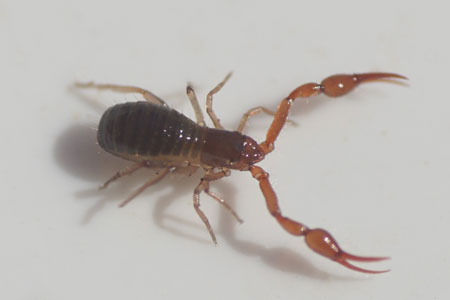
A darker pseudeoscorpion. Photos 30-3-2019. |
Acari (or Acarina) are a taxon of arachnids.
I don't know much about Mites. There are many species.
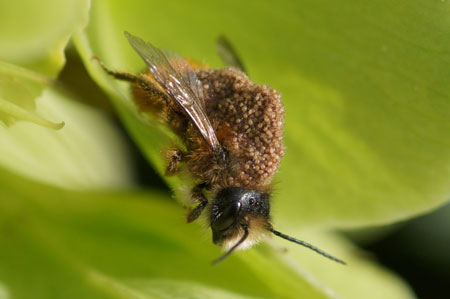 ... ...
 Hairy-fingered hairy-footed mite, Chaetodactylus osmiae. Family
Chaetodactylidae.
Hairy-fingered hairy-footed mite, Chaetodactylus osmiae. Family
Chaetodactylidae.
On this male Red mason bee (Osmia rufa = Osmia bicornis). are a lot of mites (Chaetodactylus osmiae). It suffers by the large number of them. They don't bite the bee, they lift with it to the nests of the bees. In this way the nests of mason bees may be affected by the mites. A mite feeding on eggs, larvae or pollen stock. They also lay their eggs. The larvae that hatch, also feed on the stored pollen. If the food runs out they cling to a mason bee in order to find a new nest. Photos 9-4-2014.
|
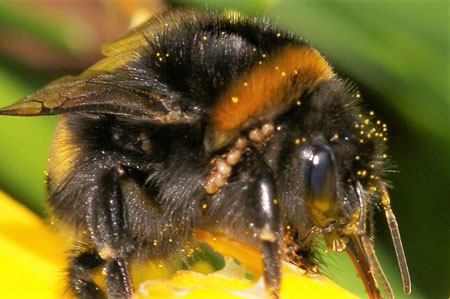 Probably the bumblebee mite Tyrophagus laevis synonym Kuzinia laevis.
It spends the winter with the queen (photo just after the winter). In the bumblebee nests they seem to live mainly on pollen, honey. They hitchhike with the bumblebee to spread, but are not harmful to the bumblebees. This is in contrast with, for example, the
Varroa destructor with honey bees. Photo 4-3-2014.
Probably the bumblebee mite Tyrophagus laevis synonym Kuzinia laevis.
It spends the winter with the queen (photo just after the winter). In the bumblebee nests they seem to live mainly on pollen, honey. They hitchhike with the bumblebee to spread, but are not harmful to the bumblebees. This is in contrast with, for example, the
Varroa destructor with honey bees. Photo 4-3-2014. |
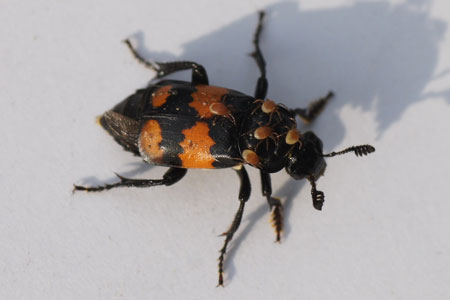 .. ..

Common Sexton Beetle
(Nicrophorus
vespilloides) with mites.
On burying beetles and scarabs you often see mites. They lift
on the beetles to other places. Sometimes the beetles are completely covered with mites. It seems
to be predatory mites of the family Parasitidae, piggybacking. Parasitidae is a family of predatory mites
Photos 21-5-2014.
|
Some mites that I find on the ground. I think predatory mites, but but I don't know more.
| Photo 7-7-2016. Taken in the dunes. Striking with long, slightly red-colored legs.
Photo 10-2-2018. Very common in the garden. Probably male, family Parasitidae.
Photo 8-2-2018. About 1 mm. Very
small. |
Moss mites or beetle mites (Oribatida).
They live in the litter and in the upper soil layer, in humus or in moist moss. They have the shape of a ball, are small and move slowly. Food varies by species.
Living and dead plants, microorganisms such as algae, bacteria and fungi. Some are predatory, but none is parasitic.
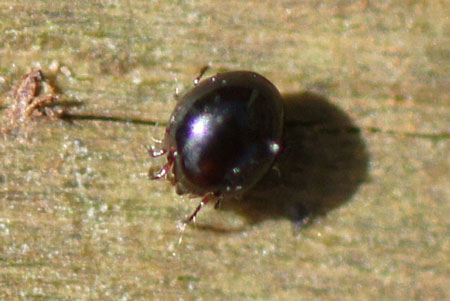 A moss mite, beetle mite (Oribatida). Smaller tham a mm.
A moss mite, beetle mite (Oribatida). Smaller tham a mm.
Spider mites (Tetranychidae).
A family of small mites (up to approximately 1 mm). Eggs are laid on the leaves, after which the young are protected by silk. They suck sap from the plant..
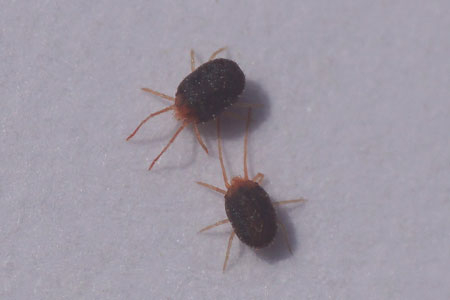 .. ..
 Bryobia kissophila. Family Spider mites (Tetranychidae).
Bryobia kissophila. Family Spider mites (Tetranychidae).
There are different Bryobia species. They live on different plants. Bryobia kissophila can be found on ivy. With us there are many.
Photos 7-5-2019.
Family Hard ticks (Ixodidae). Al Dutch species on Waarneming.
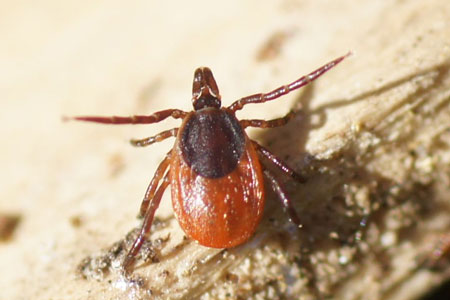 .. ..
 Castor bean tick, sheep tick (Ixodes ricinus).
Family Hard ticks (Ixodidae). Orde Acarina. Class Arachnida. Phylum (Arthropoda).
Castor bean tick, sheep tick (Ixodes ricinus).
Family Hard ticks (Ixodidae). Orde Acarina. Class Arachnida. Phylum (Arthropoda).
In fact,
it belongs with the mites on the spider page. They belong to the same
phylum (Arthropoda).
I have put a photo of a thick on this page, for as a photographer of insects
you have to be careful when you walk through nature because of the thicks. In the dunes I never had any bites, but in the
garden I am regularly bitten by
nymphs of the thick. Cats you often see with the engorged adult specimens,
but many people don't recognize a thick in nature, like the thick on this
photo.
The sheep tick feeds on many mammals, including humans. This is the most common ticks in the Netherlands, but there are more species (9).
The tick moult three times before it is mature and each time it needs blood. Photo 27-4-2015.
Photo 22-9-2015. A nymph of a tick, which
give us the most problems. (smaller than 2 mm.)
|
I want to thank everyone, who has helped me (waarneming.nl)
to identify.
Nederlands /
Dutch
 
|
